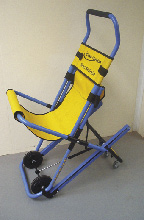During emergency operations, people with mobility restrictions are instructed to stay put or get to a stairwell - the safe harbor - until someone comes to rescue them. Wheelchair users perished on 9/11 while waiting to be rescued by firefighters, when they could have been ferried down the stairs with an emergency evacuation chair such as the EVAC+CHAIR. In fact, several disabled occupants were helped down by co-workers using this "lifeboat for stairways" while others died waiting to get down the stairs, in what became an unsafe harbor.
Hal Newman, executive director of the National Emergency Management Resource Center (NEMRC) has this to say about safe harbor: "As a former firefighter/paramedic, when someone suggests that the concept of 'safe harbor' is somehow acceptable, I tell them to try and imagine the desperation of someone they love waiting for rescue after everyone else has left the building."
As witnessed on 9/11, the old thinking of steering people to "safe refuge" to wait for help can spell disaster. For anyone with a condition that makes it difficult for them to get down stairs during an emergency, an emergency evacuation chair can mean the difference between life and death, without relying on the crucial efforts of first responders.
In addition, clearly defined evacuation plans and training are needed to ensure everyone gets out safely and quickly. No one needs to be left behind to wait for help, and first responders do not need to be burdened with additional equipment, because other occupants can manage an EVAC+CHAIR.
The EVAC+CHAIR's unique construction makes it easy for nearly anyone to assist a disabled co-worker, family member or friend down the stairs. The narrow profile and light weight of the EVAC+CHAIR means it does not interfere with the ascent or descent of first responders (or other building occupants) sharing the stairway. The chair is engineered to convey smoothly using a patented continuous rotating V belt that ensures safety and allows the user to control the chair's descent down the stairs with relative ease, regardless of the passenger's size.
The EVAC+CHAIR, the original stairway evacuation chair, was developed in New York City in 1982 and is the worldwide industry standard in lightweight, portable evacuation chairs. It is used internationally in hotels, hospitals, office buildings, schools, assisted living facilities, public venues and residential and commercial high-rise buildings—any multi-story facility where tenants or occupants who need help for any reason can descend the stairs to safety. Its patented design allows most able-bodied users to assist those with mobility impairments or other conditions in need of help in an emergency.
"Everyone has the right to get out alive," Newman said. "Every member of your team - including individuals with special needs - should have an evacuation plan. If that plan calls for specialized gear, then you should invest in the best and implement it immediately."
In short, building owners, developers and managers are wise to make sure that evacuation devices are in place along with evacuation plans. In terms of ADA compliance, inclusivity, liability and life safety, egress issues should be at the top of the management checklist. After all, it doesn't take a disaster the level of the Twin Towers attack to keep in mind the importance of getting all occupants out of a multi-story building safely.
Richard Perl is vice president of business development for EVAC+CHAIR North America, Lake Success, N.Y.

Thanks for Reading!
You've read 3 of your 3 guest articles
Register and get instant unlimited access to all of our articles online.
Sign up is quick, easy, & FREE.
Subscription Options
Sign up is quick, easy, & FREE.
Already have an account? Login here







